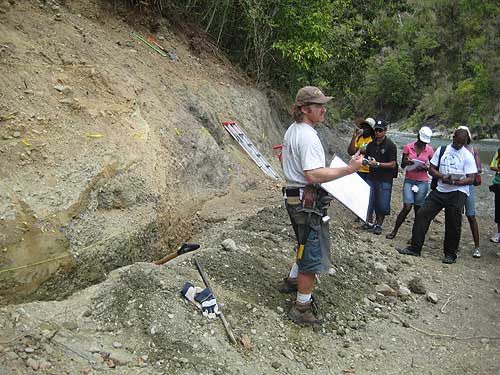 By NED ROZELL January 28, 2010
The National Science Foundation set up a "rapid response team," and team leader Paul Mann of the University of Texas at Austin selected Koehler, who works for the Alaska Division of Geological and Geophysical Surveys, to join the team because of his experience in the Caribbean. Koehler will travel to Haiti for two weeks to help document scars on the ground torn by the magnitude 7 earthquake.  Photo by Paul Mann
"It's pretty critical to map these surface structures before they get eroded or before people run them over with bulldozers," he said. Koehler and about six others will fly into the Dominican Republic and get to the Port-au-Prince area however they can, looking for expressions of the earthquake on the ground. As he prepared to leave Fairbanks, Koehler viewed satellite images of the area and wrote down the locations of interesting features the team would like to visit by foot, or with the help of Dominican helicopter operators. The group will be on the Enriquillo-Plantain Garden Fault, which has generated large earthquakes on the island of Hispaniola (which includes Haiti and the Dominican Republic) in 1751 and 1770, and in Jamaica in 1692 and 1907. Mann, the University of Texas at Austin researcher, has studied the fault for years. He wrote this in an abstract for a 2008 conference: "Since the last major event in south-central Dominican Republic was in 1751, that yields about 2 meters of accumulated strain deficit, or a (magnitude) 7.2 earthquake if all is released in a single event today," he wrote. "The two largest cities within 30 km of the fault zone are Port-au-Prince, Haiti, and Kingston, Jamaica, with a combined population of 3.65 million inhabitants." Koehler has worked with Mann on the same fault system and has traveled on similar missions after large earthquakes in Turkey, Taiwan, and other countries. He is now packing a voice recorder for field notes, a GPS, first aid kit, water bottles, a compass and a few tape measures, including a 40-foot tape he may need to measure rips in the ground surface caused by the earthquake. The geologists will use the information to help forecast future earthquakes. "What we're doing is important not only in Port-au-Prince but globally," he said. "Figuring out recurrence intervals of large earthquakes is important to Alaska and any area with active faults." Koehler said he's prepared to assist earthquake victims who might need the team's help, but the scientists will be focused on gathering data. And he's planning to sleep anywhere he can, though probably not under a roof. "There was a magnitude 6 aftershock a few days ago and two magnitude 4 aftershocks today," Koehler said Jan. 21, 2010. "Nobody's sleeping inside right now. They're too frightened. And they should be. They build these unreinforced concrete structures to withstand hurricane winds, but with strong ground motions they just crumble."
Ned Rozell [nrozell@gi.alaska.edu] is a science writer at the institute. Publish A Letter in SitNews Read Letters/Opinions
|